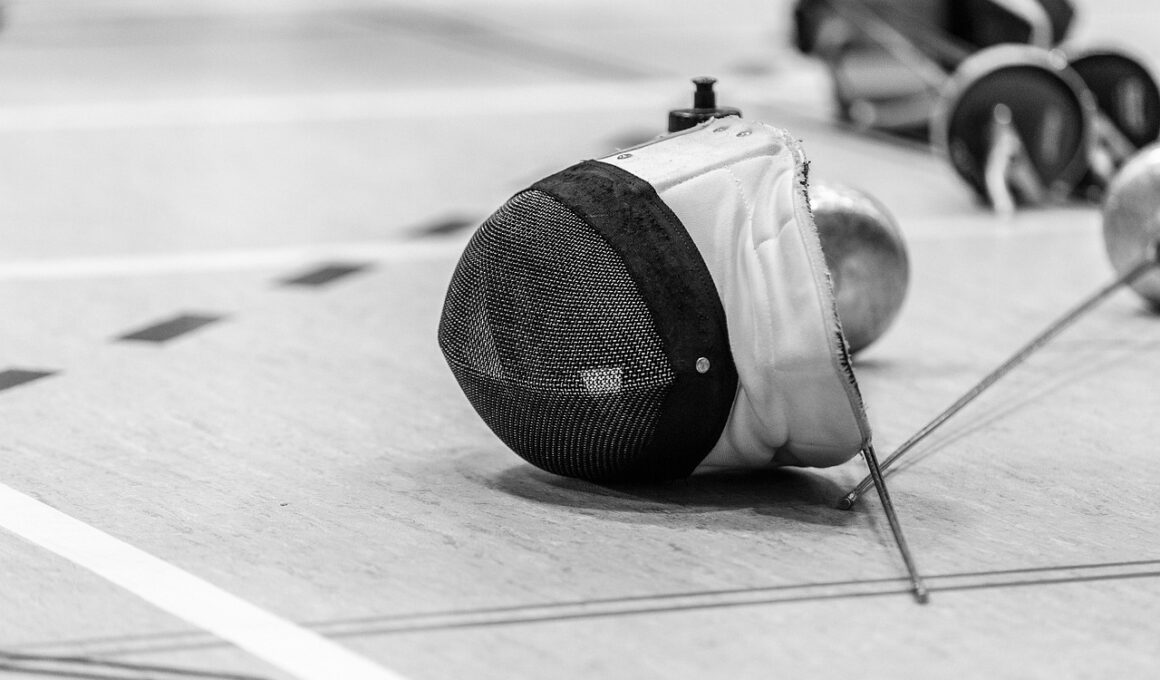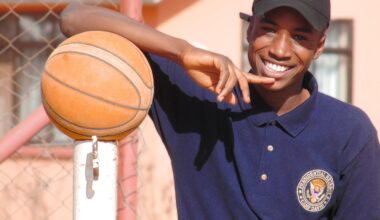The Impact of Flexibility on Fencing Agility
In the world of fencing, agility stands as a crucial element influencing performance. The sport demands quick reactions and swift movements, both of which can directly benefit from enhanced flexibility. Flexibility not only contributes to an athlete’s ability to execute complex maneuvers but also plays a significant role in injury prevention. A fencer with superior flexibility can adapt to various fencing styles more readily and withstand the physical stresses of the sport. This adaptability can greatly affect match outcomes as it allows athletes to respond effectively to their opponents’ actions. Moreover, enhanced flexibility supports greater balance and body control, key attributes needed when maneuvering around the fencing strip. Through consistent flexibility training, fencers can achieve a wider range of motion, which is particularly beneficial during lunges, attacks, and defensive movements. Incorporating flexibility exercises into training routines helps in developing muscle elasticity and joint mobility. Overall, the integration of flexibility training into fencing practice not only maximizes an athlete’s agility but also fortifies their overall physical robustness against injuries. The synergy between flexibility and fencing experience is indeed remarkable, showcasing its prominence in achieving optimal performance.
Flexibility training techniques are varied and can be tailored to meet individual needs. Dynamic stretching serves as an excellent warming-up method that enhances flexibility while preparing the muscles for rigorous fencing practice. Through techniques like arm circles, leg swings, and torso twists, fencers can gradually elevate their range of motion. Additionally, static stretching plays a pivotal role in post-training routines, focusing on lengthening muscle fibers and promoting relaxation. Examples include sitting toe touches and butterfly stretches which specifically target critical muscles used in fencing. These techniques not only maintain but also incrementally improve overall flexibility, which facilitates the execution of advanced fencing techniques. Incorporating both dynamic and static stretches ensures a comprehensive approach to flexibility training. Importantly, fencers should aim to devote time to their stretching routines regularly, allowing for continual gains. Beyond just physical benefits, increased flexibility fosters greater mental confidence, enabling athletes to engage more freely in their matches. Research further supports that those who incorporate flexibility training tend to show significant improvements in their overall performance metrics on the strip, suggesting a direct correlation between flexibility and fencing success.
The Role of Core Strength
Core strength enhances flexibility, further contributing to improved agility in fencing. The core acts as a central unit that facilitates effective movement and energy transfer between the upper and lower body. A well-conditioned core aids fencers in executing precise footwork while maintaining excellent posture. Throughout various actions, be it attacking or defending, a powerful core enhances stability, allowing for efficient movement transitions. Engaging muscles like the abdominals, obliques, and lower back builds endurance and strength necessary for quick lateral shifts, crucial during bouts. Flexibility, when combined with core stability, allows fencers to perform complex movements with more confidence and effectiveness. To develop core strength, fencers may incorporate exercises such as planks, leg raises, and medicine ball rotations into their training regimen. As the core strengthens, flexibility tends to improve as well, creating a holistic training balance crucial for competitive success. The relationship between core strength and flexibility is synergistic; enhancing one invariably strengthens the other. Therefore, fencers must pay attention to their core training regimes to complement their flexibility adaptations, leading to superior agility and performance outcomes on the strip.
Recovery practices should also integrate flexibility training to maximize benefits. Post-practice stretching helps fencers recover more efficiently by reducing muscle tension and soreness. Active recovery methods, such as yoga and Pilates, focus on elongating and relaxing the body, which can significantly enhance flexibility and agility. These practices not only provide physical benefits but also promote mental clarity, necessary for competitive focus. Further, participating in such activities encourages fencers to develop a stronger body awareness that translates well into their tactical movements. Regular recovery practices allow fencers to prepare their bodies adequately for subsequent training sessions, ultimately leading to better performance. Incorporating foam rolling techniques into recovery routines can also benefit muscle recovery and flexibility by increasing blood flow and reducing fascia tightness. The notion that flexibility training is vital to recovery cannot be understated; adjustable muscles lead to quicker rehabilitation processes when faced with discomfort or fatigue. Therefore, fencers should integrate flexibility-focused recovery methods into their schedules to harness the side benefits for performance enhancement. Ultimately, investing time towards flexibility recovery correlates with sustained vitality as athletes advance in their fencing careers.
The Importance of a Tailored Approach
Flexibility training for fencers should be personalized according to each athlete’s unique needs and capabilities. Individual assessments can establish specific flexibility goals, recognizing that not all athletes possess the same natural range of motion. Consequently, program designs will vary significantly based on personal objectives, whether aiming for improved footwork or a more dynamic lunge stance. Incorporating flexibility exercises that align with specific fencing styles is crucial for achieving optimal outcomes. Personalized programs might also include targeted stretches that address common muscle tightness areas prevalent in fencers. A dedicated coaching approach that emphasizes personalized flexibility training enhances the longevity of athletes’ careers. Regular evaluations allow coaches to modify training plans to continually challenge fencers while safeguarding against injuries. Ongoing open communication concerning athletes’ progress is essential in refining flexibility strategies, ensuring that adjustments align with evolving performance needs. Furthermore, depending on age, experience, and competition level, flexibility training might include diverse approaches suitable for young learners versus seasoned performers. This tailored flexibility strategy fosters a deeper commitment to the training regimen, ultimately leading to superior agility, robustness, and competitive success in fencing.
To sum up, flexibility remains a cornerstone of agility, directly impacting performance in fencing. Emphasizing the relationship between flexibility and agility enables fencers to unlock their potential effectively. Implementing flexibility training programs not only enhances physical capabilities but also leads to mental confidence, a critical factor during matches. The dual focus on core strength synergistically complements flexibility, driving improved agility and overall performance. Flexible fencers can swiftly adjust their movements, respond integration to their opponents, and execute innovative techniques smoothly. Recovery practices that incorporate flexibility techniques contribute further to athletic longevity and performance stability, underscoring the importance of looking after the body holistically. Thus, a focus on tailored flexibility training solutions will allow fencers to reach optimal performance levels depending on their unique needs. Engaging coaches and physiologists adept in crafting individualized flexibility plans can be immensely beneficial in achieving these goals efficiently. Ultimately, integrating flexibility education into fencing coaching at all levels fosters an environment where excellence can be consistently pursued and realized. The commitment to flexibility training will undoubtedly shape the next generation of agile fencers, setting new benchmarks in competitive success.
Call to Action for Coaches and Athletes
Embracing the significance of flexibility in fencing is essential for both coaches and athletes. By prioritizing flexibility training within coaching curriculums, coaches can equip fencers with the necessary tools to enhance their performance. Providing resources and expertise on effective flexibility techniques serves to elevate not only individual athletes but the fencing community as a whole. Coaches are encouraged to incorporate flexibility training sessions on a regular basis, making it a pivotal part of each practice. Additionally, athletes should take personal responsibility for their flexibility routines, actively participating in various stretching practices outside of the strip. Together, these measures can create a comprehensive approach to training that emphasizes overall athletic development. Fencers are advised to undertake flexibility assessments early in their training, enabling targeted flexibility improvements and enhancing agility systematically. The journey toward optimal flexibility requires commitment from all involved; fostering this culture within fencing communities can lead to remarkable improvements in athlete preparedness, performance, and overall enjoyment of the sport. Ultimately, a dynamic commitment to flexibility can redefine standards of excellence within fencing, ultimately driving positive change across the discipline.
In conclusion, flexibility directly impacts fencing agility by enhancing athletes’ physical capabilities and their overall mental readiness. As fencers navigate through their matches, the significance of agility highlighted by flexibility becomes increasingly apparent, underscoring its integral role in differentiating competitive performance. Coaches and athletes alike must acknowledge the undeniable benefits of integrating structured flexibility training into their routines consistently. By fostering a culture that values flexibility, the sport will accelerate its growth while nurturing competent fencers to pursue excellence. A tailored approach remains paramount; understanding that each fencer’s journey can vary ensures that targeted training remains effective. Flexibility training’s combination with core strength and recovery practices creates a well-rounded athlete prepared for the demands of competition. Moreover, encouraging open communication about flexibility goals sets the groundwork for fostering trust between coaches and athletes, which is crucial in gymnastics. The commitment to flexibility must stand as a foundational principle within fencing coaching. As practitioners throw open this door of discovery, they will find remarkable transformations in agility, techniques, and performance throughout their careers in fencing.


